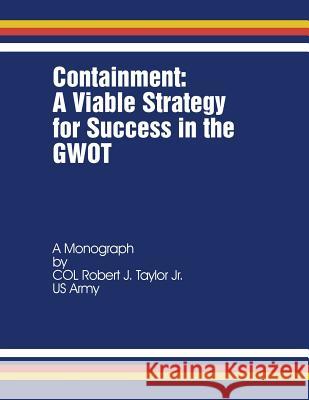Containment: A Viable Strategy for Success in the GWOT » książka
Containment: A Viable Strategy for Success in the GWOT
ISBN-13: 9781481879859 / Angielski / Miękka / 2012 / 70 str.
The purpose of this monograph is to investigate the nature of militant Islam in the context of a global ideological threat; to further examine the strategic concepts associated with the theory of containment developed to win the Cold War; and propose an alternative national strategy of containment to successfully execute the Global War on Terrorism (GWOT). The first section defines the nature of the global threat of militant Islamic fundamentalism, and its goals regarding expansion and the threat to the US and the West. The defined threat was derived through research of current US national strategy documents and the declassified national intelligence assessment, recent academic publications, and released statements and publications of militant leaders such as Osama bin Laden and Ayman Zawahiri. Once defined, key similarities of this current and future threat and the Cold War threat of Soviet Communism are identified from primary documents on American policy and strategy from 1945-1950, and secondary sources associated with the strategy of containment. The critical aspect of this comparison is the analysis of regional and global aims of the threat, and intentions for expansion. This comparison is not exhaustive, but merely adequate to ensure that a counter-strategy of containment is worth pursuit. The key element is the comparison of the similarities of ideological threats across all spectrums of international power and influence. The second section analyzes the successful Cold War strategy of containment and identifies key concepts that can be successful in the containment of militant Islam. The analysis focuses on former national programs designed to leverage the elements of power in support of containment of Soviet communism. Sources for this section are documents on American policy and strategy that originated between 1945 and 1950 that focus on containment strategy and secondary sources that analyze the concepts and doctrine of containment itself. The third section proposes a viable strategy of containment based on George F. Kennan's Cold War containment strategy to counter militant Islam and successfully prosecute the GWOT in terms of a "long war." Some modifications for context and specifics of the threat are applied to make such a strategy most effective today. The criteria used to analyze the viability of a strategy of containment for the GWOT is founded on a definition of the theory of strategy and a common model for analyzing and evaluating strategy by breaking it into its component parts. Using Art Lykke's definition of strategy and his model, the proposed strategy of containment is evaluated to determine acceptability, feasibility, and suitability to prosecute the global war on terrorism. Militant Islam has proven itself to be the only truly totalitarian movement in the world today, and regards itself as the only rival, and the inevitable successor to Western civilization. This form of extremism is extricable from Islam itself, but the US cannot unilaterally fix the internal problems of the Muslim world. However, the US can provide critical help while at the same time defending the American population at home. A strategy of containment modified for the current realities of the post Cold War world against a new global threat with similar tendencies is viable and worth strong consideration. A cornerstone of the strategy is weakening militant Islamists where they are in power, containing their expansion, and better encouraging vulnerable governments to resist. This approach takes advantage of strategic concepts of containment previously successful in winning a "long war." The threat of expansion of militant Islam is indeed a global threat similar to that of the global threat of Communism, and a comprehensive strategy of containment similar to that of previous successful US strategies during the Cold War provides a fundamental basis for a successful long term contemporary strategy to contain it.
Zawartość książki może nie spełniać oczekiwań – reklamacje nie obejmują treści, która mogła nie być redakcyjnie ani merytorycznie opracowana.











